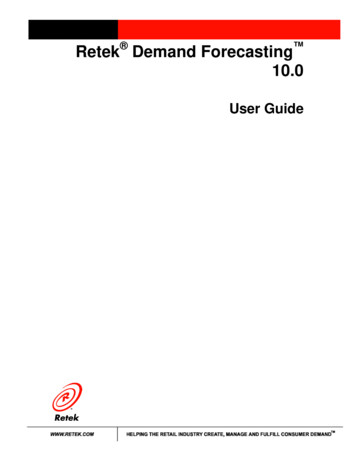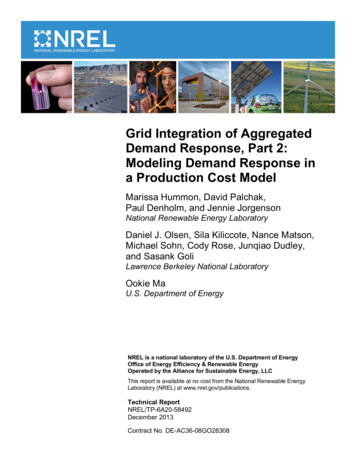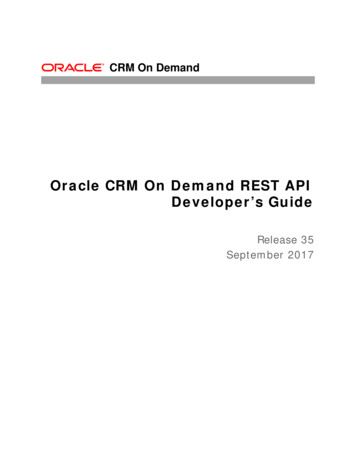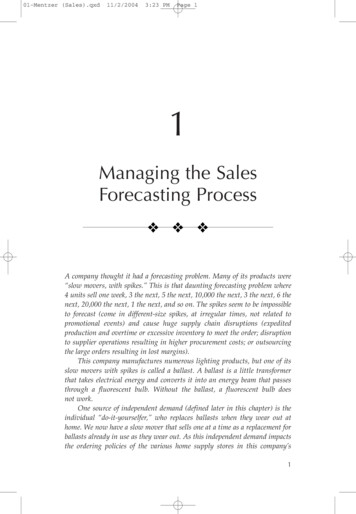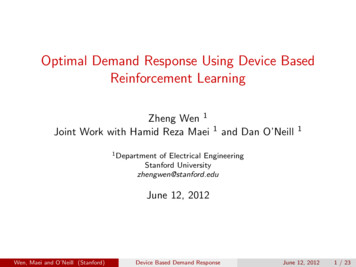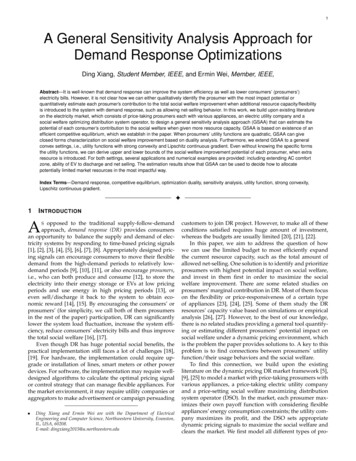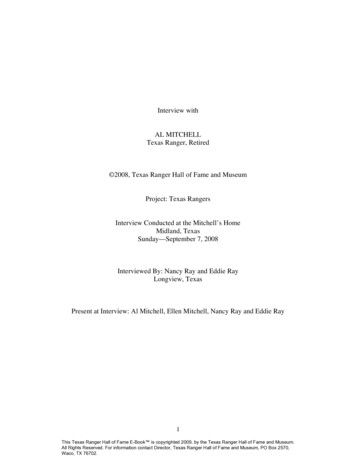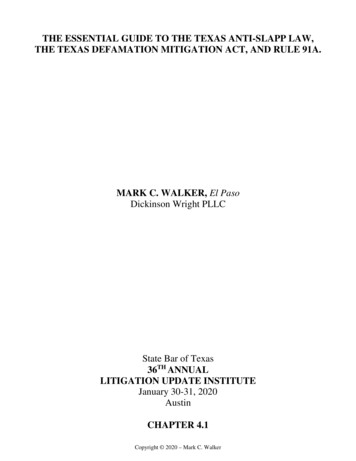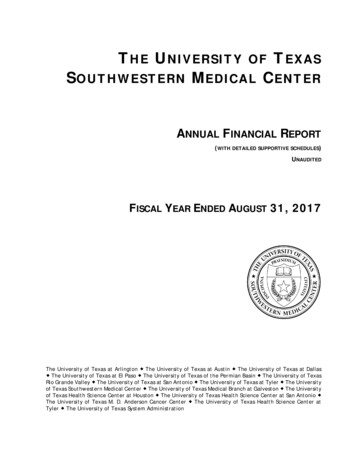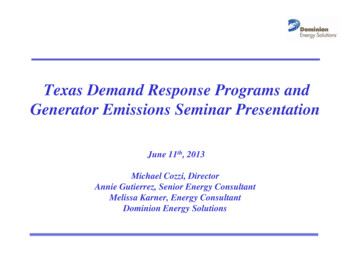
Transcription
Texas Demand Response Programs andGenerator Emissions Seminar PresentationJune 11th, 2013Michael Cozzi, DirectorAnnie Gutierrez, Senior Energy ConsultantMelissa Karner, Energy ConsultantDominion Energy Solutions
Outline IntroductionERCOT Resource Adequacy and Reserve MarginsDemand Response DefinedSummary of Demand Response ProgramsCurtailment Strategies and ExamplesFinancial ProformaGenerator Emissions UpdateConclusion2
Our Business Model We do business under trade name, “Dominion Energy Solutions” to reinforcethe Dominion brand that is recognizable to many large commercial andindustrial energy users throughout the U.S. Dominion Energy Solutions (“DES”) is an energy management servicescompany owned by Dominion Resources. We provide energy procurement services for electric and natural gas to largecommercial, industrial, and educational clients. We are a demand response service provider (e.g. sometimes referred as“Aggregator”) in the ERCOT electric market in Texas. We are registered withERCOT as a Qualified Scheduling Entity (“QSE”) qualified to aggregatecustomer load resources into ERCOT sponsored demand response programs. In addition, we are a demand response service provider on our proprietary4CP demand response program which helps clients reduce regulatedtransmission costs each year.3
Big Picture – ERCOT Grid ResourcesMarket OverviewSCADA DataCustomer MeterReadsLoss InformationBalanced Schedules& Ancillary ServiceBidsBalanced Schedules& Ancillary ServiceBidsQSE2.QSEnTDSPResource Schedules and BidsLoad SchedulesOur CustomerLoad REPREP2nResourcesREP1Residential Shared revenue from demandresponse. No gaps in communications.QSE1ResourcesClient load resources gain on allfrontsSmallCommercialLargeCommercialIndustrial Direct QSE relationship to theERCOT market with DES. Bid strategy and marketintelligence through affiliation withDES. First responder to all facilities onERCOT ERS test notices to rungenerators. DES is committed to our clients4
Resource Adequacy is a Major issue in ERCOTWind *Gas *ForecastStorage *Coal *Forecast 13.75% ReserveSolar *Projects w/ SGIAPetCoke *Current Resources* Projects under Full Study90,00085,000Firm Load Forecast 13.75% Reserve80,000MW75,000Firm Load Forecast70,000Resources65,000Expected Load Carrying Capacity(ELCC) for Wind is 8.7%New generation is notbeing built quick enoughto meet demand. Demandresponse is an 202020212022ERCOT Dec 2012 Capacity, Demand & Reserves (CDR) Report: http://www.ercot.com/news/presentations/Paul Wattles, ERCOT, Presented at Data Center Dynamics, Dec 11, 2012
Off-peak vs. on-peak load by customer typeWed., Aug. 3, 20115:00 PMERCOT Load: 68,416 MWTemperature in Dallas: 109 WednesdayMarch 9, 20115:15 PMERCOT Load: 31,262 MWTemperature in Dallas: 64 Residential51.2%( 35,000 MW)Residential 27.4%( 8,500 MW)Small Commercial25.2%Small Commercial 28.9%Large C&I43.7%3/9/2011 IE 17:15Large C&I23.7% Customer class breakdown isfor competitive choice areas;percentages are extrapolatedfor munis and co-ops toachieve region-wide estimate Large C&I are IDR MeterRequired ( 700kW)8/3/2011 IE 17:00Paul Wattles, ERCOT, Presented at Data Center Dynamics, Dec 11, 2012
What is Demand ResponseTemporary reduction of power in response to gridreliability and/or economic conditions.7
Capital Efficiency of Meeting Peak Electric Demand100%% of System Peak Demand90%75%50% 10% of infrastructurecosts are spent to meet peakdemand that occurs lessthan 1% of the time25%0%WinterSpringSummerFallAnnual US Electricity Demand - % of PeakDemand response is a cost-effective and reliable way to meet peak demand.
kWReliabilityGenerationCapacityDemandWith DR24 HoursReliability/Security – DR can be brought to market morequickly and precisely than comparable generation or T&D,giving grid operators resources needed to better managereliability NOW while paying end-users to tap into existingresources.SupplyDemand Plant 1’sCapacity Plant 2’sCapacityYour Building’sDemand Plant 3’sCapacityNext Building’sDemandNextBuilding’sDemandIf Load Increases . . .1Build generatorBuild generatorBuild generator2Be more efficientCurtail during critical peaksShift consumptionDemand response is achieved when end-users reduce their power demand inresponse to grid reliability issues or peak price signals.9
Demand Response Programs in ERCOT MarketEMERGENCY RESPONSESERVICE (ERS) 10-MINUTEEMERGENCY RESPONSESERVICE (ERS) 30-MINUTE(PILOT)COMMERCIAL LOADMANAGEMENT (CLM)Four Coincidental Peaks (4CP)MEDIUMMEDIUM-LOW TO MEDIUMLOWLOWTDSP EMERGENCY30 MINUTESMANUAL35KSUMMER 4-MONTHSNOVEMBER CHECKNONECOST AVOIDANCE2-3 HOURSMANUAL22K - 30KSUMMER 4-MONTHSCOST AVOIDANCENONERISKRESPONSENOTIFY TIMEPROCESSGROSS REVENUE ( /MW/Yr)PERFORMANCE PERIODPAYMENT METHODUPRONT COSTMAX. HOURS OF CURTAILMENTSENROLLMENTMIN. CURTAILABLE LOAD REQ.METER TYPENOTIFICATIONERCOT EMERGENCY - EEA 1ERCOT EMERGENCY - EEA 2OR 210 MINUTES30 MINUTESMANUAL OR W/ TECHMANUAL OR W/ TECH40K-60K30K-50KTHREE 4-MONTH TRANCHES THREE 4-MONTH TRANCHESCHECK PER PERIODCHECK PER PERIODNONENONE8 HOURS*AUCTION EVERY 4 MONTHS100 kW*IDR/PROPRIETARYPHONE/EMAIL8 HOURSAUCTION EVERY 4 MONTHS100 kW*IDR/PROPRIETARYPHONE/EMAIL 17 HOURS3RD QUARTER PREV YEAR100 KWIDRPHONE/EMAIL18-JunPRIOR TO SUMMERNO MINIMUMIDRPHONE/EMAILERCOTERCOTCENTERPOINTDOMINION ENERGYSOLUTIONSEVENTS FEB 2011, AUG 20115 EVENTS IN 20121 TEST AND 1 EVENT IN 2012DAILY FORECASTNOTIFICATIONSSPONSORCOMMENTSSUMMER XXXXJUNXXXXJULXXXXAUGXXXXSEPXXXXOCTNOVDECXXXXXX
Overview of 4CP In deregulated ERCOT, client’s electric bill has two main sections: Supply costs (i.e. the rate per kWh a client pays for electricity) which isprocured via a competitive supplier such as TXU. Regulated charges assessed by the Transmission Distribution ServiceProvider (i.e. AEP, Oncor, Centerpoint,) for the physical delivery of theelectricity. Two components of the “4CP” (Four Coincident Peaks) tariff appear on eachmonthly bill under: Transmission Transmission Cost Recovery Factor (TCRF) Large end-users can reduce, or mitigate all together, their 4CP charges throughparticipation in Dominion Energy Solution’s proprietary 4CP demandresponse program.11
SCREEN PRINT from OncorTariff:How 4CP is calculatedSECPRITRANSONCOR 2.550483 2.548630 2.665781CENTERPOINT 2.553659 2.445285 2.462328AEP 2.426300 2.706378 2.466264TNMP 2.656781 2.597929 1.702469COSERV 2.568840 2.568354 2.636809In other words, the average of the client’s demand during the 4CP times is multiplied bythe respective tariff and assessed monthly, the entire calendar year following the 4CPseason. 50% increase vs. 2007These rates have increased YOY, and can increase 3x peryear 12Confidential & Proprietary Information12
Data Center Performance on 4CP Demand ResponseMcKinney Experian1,8006/26/2012 16:307/31/2012 17:001,6008/1/2012 17:001,4009/5/2012 17:001,200kW1,0008006004CP Interval (Ending)6/26/2012 16:304CP kW0.007/31/2012 17:008/1/2012 17:000.000.009/5/2012 17:000.004000.0AVG100%Assumed Power Factor:Adjusted 4CP kW:200TCRF / Trans Chrg (Oncor Svc):0 2.568840Annl Cost (Sec Svc): :151:150:15-Data center client eliminated over 45,000 in annual regulated transmission costs13
What factors make an ideal client for demand response? Minimum of 100 kW (formerly 1,000 kW) peak demandInterval Data Recorder (IDR) or Smart Meter measures demand 15 min intervalsPreferably operate multiple shifts of operation (7x24 is most preferable).Ability to curtail/reduce load quickly– Within 10 min for ERS 10– Within 30 min for ERS 30– Within 30 to 60 min for CLM– Within 150 min for 4CPDesire to reduce costs and generate revenue. Contribute towards meeting corporatefinancial goals and budgets.Desire to become more energy efficientDedicated and committed to performing demand responseGood business relationship with existing Cirro client.Meets target vertical segments (see next page).14
Client BenefitsFINANCIALOPERATIONALENVIRONMENTALERS provides cash payments multiple times per year, even if thereare no unscheduled events.4CP provides savings on regulated utility charges for entire year.CLM provides cash payments 1 to 2 times per year, even if thereare no unscheduled events.Early warning of potential grid failureOpportunity to help stabilize grid which stabilizes your businessOpportunity to get on highest quality and most reliable power (e.g.,generator) with grid as backupDemand response acts as a capacity resource, helps offset need forincremental generation, reducing emissionsHelps stabilize grid, less emissions vs. rolling black outs15
Demand Response Proforma for 1 MW Curtailable LoadStartJun13-Sept13Bid Period HoursBus Hours (0800 -1300 M-F)4CP - Mon-Friday 3-5PMCLM - Mon-Friday 1-7PMNon-Bus Hours (All other hrs incl sat sun)EILS BID PERIODOct13-Jan14Bid Period HoursBus Hours (0800 -1300 M-F)Peak 1 Hours (1300 - 1600 M-F)Peak 2 Hours (1600 - 2000 M-F)Non-Bus Hours (All other hrs incl sat s4202523361945StartFeb14-May14Bid Period HoursBus Hours (0800 -1300 M-F)Peak 1 Hours (1300 - 1600 M-F)Peak 2 Hours (1600 - 2000 M-F)Non-Bus Hours (All other hrs incl sat sun)Notes:80%Price 8.15 30.95 35.00 7.90Gross Payment 3,423.00 30,950.00 38,500.00 15,168.00 88,041.00 MW1.001.001.001.00 DES uipment &Install Cost -Comm FeeNet to Client -64,550.20Client Share %Price Gross Payment 8.15 3,423.00 8.71 2,194.92 8.68 2,916.48 7.90 15,365.50 23,899.9067% Net of QSE2,396.101,536.442,041.5410,755.85 DES Fee1,026.90658.48874.944,609.65 16,729.93 7,169.97EndMW1.001.001.001.0067%80%70%Equipment &Install Cost -Comm FeeNet to Client -16,729.93Client Share %2/1/14 5/31/14Hours4252553401859#REF!Net of 10/1/13 1/31/142953ERSClient Share %6/1/13 9/30/1380%Price Gross Payment 8.15 3,463.75 8.71 2,221.05 8.68 2,951.20 7.90 14,686.10 23,322.10Total year 1ERS compensation paid in cashGrossCLM compensation paid in cash 135,263.004CP savings is reflected and realized on monthly electric invoices from REP Net of QSE2,424.631,554.742,065.8410,280.2716,325.4767% DES t &Install Cost -Comm FeeNet to Client -Total year 1 Net Total DES Year 1 Total EquipmentTotalof QSEFeeCostComm Fee 97,605.60 37,657.40 -16,325.47Total Net toClient year 1 97,605.60Hypothetical 1 MW DR Capacity in ERS, CLM, and 4CP demand response programs16
Emissions Rules Related to EmergencyPower Generation and Demand ResponseIf anyone has questions PLEASE contact us via email/phoneand we will respond accordingly.17
Appendix(Back-Up Slides)18
RICE NESHAP –January 30, 2013 Amendments: Background EPA finalized amendments to the RICE NESHAP in 2010 that establishedstandards for certain existing engines After promulgation of the 2010 amendments, EPA received several petitionsfor reconsideration, petitions for judicial review, and other communicationsregarding several issues with the final rules On January 30, 2013 (78 FR 6674), EPA finalized amendments to theNESHAP to address the petitions– Amendments effective April 1, 2013– Minor amendments/clarifications also made to NSPS One of the major issues addressed in final Amendments includedEmergency Engine operation for demand response and peak shaving.19
Emergency Engine Operation Limitations Emergency engine operation limited to:– Unlimited use for emergencies (e.g., power outage, fire, flood)– 100 hr/yr for maintenance/testing and emergency demand response– 50 hr/yr of the 100 hr/yr allocation can be used for: non-emergency situations (if no financial arrangement) local reliability (existing RICE at area sources of HAP only) peak shaving until May 3, 2014Note: EPA did not finalize the proposed 50 hour provision for peak shavinguntil April 201720
Emergency Engine Operation Limitations Operation for emergency demand response allowed if:– Energy Emergency Alert Level 2 declared by Reliability Coordinator, or– Voltage or frequency deviates by 5% or more below standard Operation for local reliability allowed if:– Engine is dispatched by local transmission/distribution system operator– Dispatch intended to mitigate local transmission and/or distributionlimitations so as to avert potential voltage collapse or line overloads– Dispatch follows reliability, emergency operation, or similar protocols thatfollow specific NERC, regional, state, public utility commission, or localstandards or guidelines– Power provided only to facility or to support local distribution systemOwner/operator21
TCEQ Emissions Rules and Changes TCEQ stands for “Texas Commission Environmental Quality” Title 30 TAC Chapter 106.511, Permit by Rule (PBR) §106.511. Portable and Emergency Engines and Turbines. Internal combustion engine and gas turbine driven compressors, electricgenerator sets, and water pumps, used only for portable, emergency, and/orstandby services are permitted by rule, provided that the maximum annualoperating hours shall not exceed 10% of the normal annual operating scheduleof the primary equipment; and all electric motors. For purposes of this section,“standby” means to be used as a “substitute for” and not “in addition to” otherequipment. Per the TCEQ, “If a generator is run when directed by ERCOT as part of theERS declared emergency at Step 2/3 of their EECP, they will be in compliancewith the intent of PBR 106.511”22
TCEQ Rule Changes for ERCOT ERSRule 2012-025-117-AISummary of what the rulemaking effective 5/2/2013 will do: The adopted rulemaking amends Chapters 101 and 117 to update references to ERCOT protocolsand reflect changes to ERCOT’s new ERS program. The adopted rulemaking amends §101.379 andthe definition of emergency situation in §117.10 to reference the version of the ERCOT nodalprotocols effective June 1, 2012. The adopted rulemaking also amends the definition of emergencysituation in §117.10 to reflect changes made by ERCOT to promote reliability during energyemergencies by allowing the operation of generators for purposes of selling power to the electricgrid under limited circumstances. The amendments to Chapters 101 and 117 will be submitted to theUnited States Environmental Protection Agency (EPA) as a revision to the state implementation planEffect on the: Regulated community: The adopted rulemaking will prevent ERS program participants frompotentially losing exemption status under Chapter 117 if they provide power to the electrical gridduring an ERCOT-declared energy emergency. Eliminating this potential disincentive may improvereliability of electric service in the ERCOT region while also promoting participation in the ERSprogram. Public: The adopted rulemaking will prevent ERS program participants from losing exemptionstatus under Chapter 117 if they provide power to the electrical grid during an ERCOT-declaredemergency. Eliminating this potential disincentive may help promote participation in the ERSprogram and improve reliability of electric service in the ERCOT region.23
TCEQ Rules/Changes Under §106.511 PBR, standby use of generators must occur only as asubstitute for other equipment Historically the TCEQ has not allowed “peak shaving” under §106.511 PBR Rules that govern the submission of permit applications:– Title 30 TAC Chapter 116, Control of Air Pollution by Permits for NewConstruction or Modification– Depending on the location of your emergency generators they may alsobe subject to other TCEQ regulations including Title 30 TAC Chapter117, Control of Air Pollution from Nitrogen Compounds. Additional information can be found at http://www.tceq.texas.gov/rules24
Emergency Generation Emissions and Demand Response RICE NESHAP– Regulates HAP emissions from stationary RICE at both Major andArea sources of HAP (ALL SIZE ENGINES COVERED)– Only engines not subject: existing emergency engines located atresidential, institutional, or commercial are sources used or obligatedto be available no more than 15 hr/yr for emergency demandresponse and not used for local reliability Emergency Engine Operational Limitations– Emergency Engine operation limited to: Unlimited use for emergencies 100 hr/yr for maintenance/testing and emergency demand response25
Important Take Away’s No change in NESHAP compliance dates for existing non-emergency engines––– Still only 100 hours per calendar year for certain non-emergency operations andtesting/maintenance– Engines that operate or must be available for more than 15 hrs/year for emergency DR must burnULSD and report to EPA the date, time, and situation for operationPeak shaving allowance modified from proposal–– Emergency demand response no longer limited to 15 hours per yearLimited allowances for engines operated for emergency demand response and that are dispatchedby local authority for system reliability– May 3, 2013 – CI enginesOctober 19, 2013 – SI enginesExtension request deadline has passed for CI enginesUp to 50 hours per calendar year through May 3, 2014Applies only to existing emergency engines at area sourcesDefinitions in NSPS and NESHAP may be different than State regulations and programs underregional transmission authorities––Emergency and Non-emergency enginesEmergency DR26
27
SEC PRI TRANS ONCOR 2.5486302.550483 2.665781 CENTERPOINT 2.553659 2.445285 2.462328 12 In other words, the average of the client's demand during the 4CP times is multiplied by the respective tariff and assessed monthly, the entire calendar year following the 4CP season. 12

